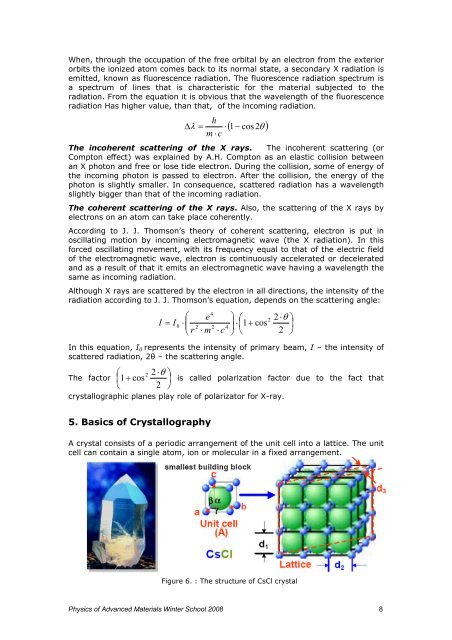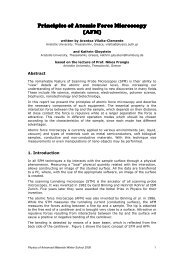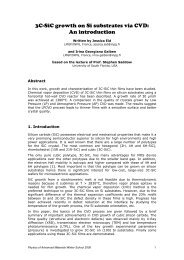The Röntgen Radiation and its application in studies of ... - Mansic
The Röntgen Radiation and its application in studies of ... - Mansic
The Röntgen Radiation and its application in studies of ... - Mansic
Create successful ePaper yourself
Turn your PDF publications into a flip-book with our unique Google optimized e-Paper software.
When, through the occupation <strong>of</strong> the free orbital by an electron from the exterior<br />
orb<strong>its</strong> the ionized atom comes back to <strong>its</strong> normal state, a secondary X radiation is<br />
emitted, known as fluorescence radiation. <strong>The</strong> fluorescence radiation spectrum is<br />
a spectrum <strong>of</strong> l<strong>in</strong>es that is characteristic for the material subjected to the<br />
radiation. From the equation it is obvious that the wavelength <strong>of</strong> the fluorescence<br />
radiation Has higher value, than that, <strong>of</strong> the <strong>in</strong>com<strong>in</strong>g radiation.<br />
h<br />
∆λ<br />
= ⋅ 2<br />
m ⋅ c<br />
( 1− cos θ )<br />
<strong>The</strong> <strong>in</strong>coherent scatter<strong>in</strong>g <strong>of</strong> the X rays. <strong>The</strong> <strong>in</strong>coherent scatter<strong>in</strong>g (or<br />
Compton effect) was expla<strong>in</strong>ed by A.H. Compton as an elastic collision between<br />
an X photon <strong>and</strong> free or lose tide electron. Dur<strong>in</strong>g the collision, some <strong>of</strong> energy <strong>of</strong><br />
the <strong>in</strong>com<strong>in</strong>g photon is passed to electron. After the collision, the energy <strong>of</strong> the<br />
photon is slightly smaller. In consequence, scattered radiation has a wavelength<br />
slightly bigger than that <strong>of</strong> the <strong>in</strong>com<strong>in</strong>g radiation.<br />
<strong>The</strong> coherent scatter<strong>in</strong>g <strong>of</strong> the X rays. Also, the scatter<strong>in</strong>g <strong>of</strong> the X rays by<br />
electrons on an atom can take place coherently.<br />
Accord<strong>in</strong>g to J. J. Thomson’s theory <strong>of</strong> coherent scatter<strong>in</strong>g, electron is put <strong>in</strong><br />
oscillat<strong>in</strong>g motion by <strong>in</strong>com<strong>in</strong>g electromagnetic wave (the X radiation). In this<br />
forced oscillat<strong>in</strong>g movement, with <strong>its</strong> frequency equal to that <strong>of</strong> the electric field<br />
<strong>of</strong> the electromagnetic wave, electron is cont<strong>in</strong>uously accelerated or decelerated<br />
<strong>and</strong> as a result <strong>of</strong> that it em<strong>its</strong> an electromagnetic wave hav<strong>in</strong>g a wavelength the<br />
same as <strong>in</strong>com<strong>in</strong>g radiation.<br />
Although X rays are scattered by the electron <strong>in</strong> all directions, the <strong>in</strong>tensity <strong>of</strong> the<br />
radiation accord<strong>in</strong>g to J. J. Thomson’s equation, depends on the scatter<strong>in</strong>g angle:<br />
⎛<br />
I = I ⋅ ⎜ 0<br />
⎝ r<br />
2<br />
e<br />
⋅ m<br />
4<br />
2<br />
⋅ c<br />
4<br />
⎞ ⎛ 2 2 ⋅θ<br />
⎞<br />
⎟ ⋅⎜1<br />
+ cos ⎟<br />
⎠ ⎝ 2 ⎠<br />
In this equation, I0 represents the <strong>in</strong>tensity <strong>of</strong> primary beam, I – the <strong>in</strong>tensity <strong>of</strong><br />
scattered radiation, 2θ – the scatter<strong>in</strong>g angle.<br />
⎛ 2 2 ⋅θ<br />
⎞<br />
<strong>The</strong> factor ⎜1+<br />
cos ⎟<br />
⎝ 2 ⎠<br />
is called polarization factor due to the fact that<br />
crystallographic planes play role <strong>of</strong> polarizator for X-ray.<br />
5. Basics <strong>of</strong> Crystallography<br />
A crystal consists <strong>of</strong> a periodic arrangement <strong>of</strong> the unit cell <strong>in</strong>to a lattice. <strong>The</strong> unit<br />
cell can conta<strong>in</strong> a s<strong>in</strong>gle atom, ion or molecular <strong>in</strong> a fixed arrangement.<br />
Figure 6. : <strong>The</strong> structure <strong>of</strong> CsCl crystal<br />
Physics <strong>of</strong> Advanced Materials W<strong>in</strong>ter School 2008 8




